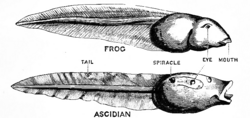Heterochrony
Heterochrony (= different time) is any change in the timing of development in an animal or plant. It is a key concept in developmental biology and evolution, introduced by Ernst Haeckel in 1875. It applies to the time a trait appears in the growth of an organism, or to the timing of gene expression in development.[1]p203[2]
Its importance in biology is to explain the way closely related animals may come to have quite large differences in shape, and size, whilst nevetheless having a rather similar genome. The main components are the time a process starts and stops in development, and the rate at which the process works.
In his book Embryos and evolution (1930) Gavin de Beer stressed the importance of heterochrony, and especially paedomorphosis, in evolution.[3] Changes to the genes which control timing in development can produce quite striking changes in the adult. de Beer also conceived the idea of clandestine evolution, which helped to explain the sudden changes in the fossil record which were apparently at odds with Darwin's gradual theory of evolution. If a novelty were to evolve gradually in an animal's juvenile form, then its development might not appear in the fossil record at all. Then, if the species were to undergo neoteny, the feature would appear suddenly in the fossil record, despite having evolved gradually.[4] Stephen Jay Gould commented on de Beer's book:
- "In a series of remarkable books that established the synthetic theory of evolution, Gavin de Beer's Embryology and evolution was the first and the shortest (1930; expanded and retitled Embryos and ancestors, 1940; 3rd ed 1958). In 116 pages de Beer brought embryology into the developing orthodoxy... for more than forty years, this book has dominated English thought on the relationship between ontogeny and phylogeny." Stephen Gould [5]
Related terms
- Paedomorphosis: a change in the genotype so the adults of a species retain traits previously seen only in juveniles.
- Progenesis: in which development is halted before full maturity.
- Postdisplacement: in which the start of development is delayed.
Heterochrony Media
Ernst Haeckel supposed that embryonic development recapitulated an animal's phylogeny, and introduced heterochrony as an exception for individual organs. Modern biology agrees instead with Karl Ernst von Baer's view that development itself varies, such as by changing the timing of different processes, to cause a branching phylogeny.
Diagram of the six types of shift in heterochrony, a change in the timing or rate of any process in embryonic development. Predisplacement, hypermorphosis, and acceleration extend development (peramorphosis, in red); postdisplacement, hypomorphosis, and deceleration all truncate it (paedomorphosis, in blue).
Despite greatly differing neck lengths, giraffes (right) have no more cervical vertebrae, just 7, than their fellow giraffids, okapi (left). With the number constrained, the development of the vertebrae is extended, allowing them to grow longer.
Axolotls retain gills and fins as adults; these are juvenile features in most amphibians.
Irish elk skeleton with antlers spanning 2.7 metres (8.9 ft) and a mass of 40 kg (88 lb)
A 1901 comparison of a frog tadpole (a vertebrate) and a tunicate larva; in 1928 Walter Garstang proposed that vertebrates derived from such a larva by neoteny.
References
- ↑ King R.C. Stansfield W.D. & Mulligan P.K. 2006. A dictionary of genetics, 7th ed. Oxford.
- ↑ Horder, Tim 2006. Heterochrony. In Encyclopedia of Life Sciences. Wiley.
- ↑ Brigandt I. 2006. Homology and heterochrony: the evolutionary embryologist Gavin Rylands de Beer (1899-1972). Journal of Experimental Zoology (Molecular and Developmental Evolution) 306B:317-328. preprint
- ↑ Jones S, Martin R. & Pilbeam D. 1992. The Cambridge Encyclopedia of Human Evolution, p104 Neoteny.
- ↑ Gould S.J. 1977. Ontogeny and phylogeny. Harvard. p221/2
+{{{1}}}−{{{2}}}






